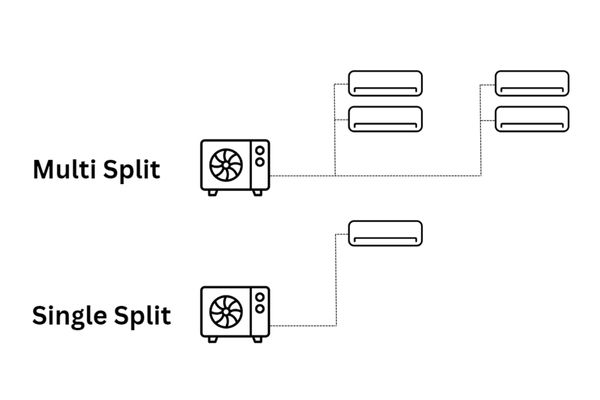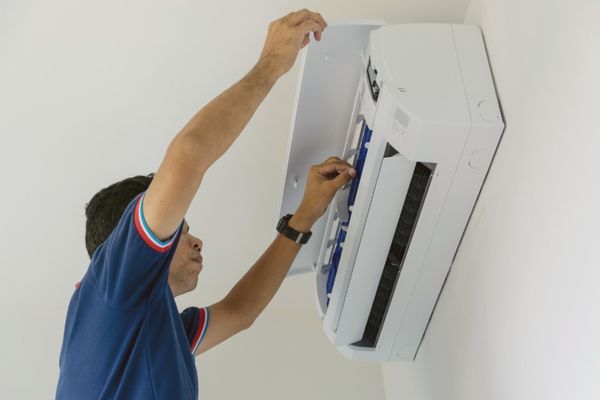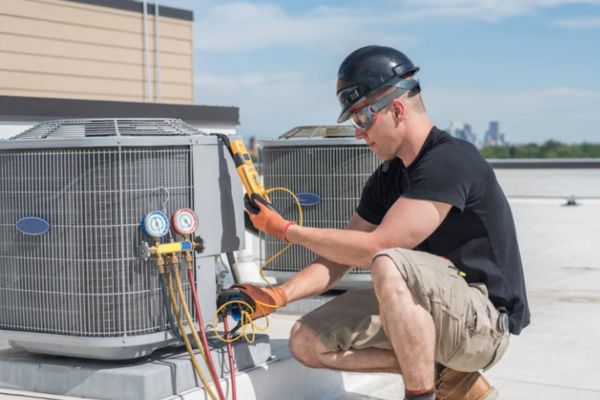Split air conditioning systems are becoming increasingly popular for both residential and commercial applications due to their efficiency and flexibility. Unlike traditional central air systems, split systems consist of two main components: an indoor unit and an outdoor unit.
The indoor unit cools or heats the air, while the outdoor unit houses the compressor and condenser. These systems are ideal for spaces needing customized cooling, allowing you to control the temperature in individual rooms or zones.

Varieties of Split Systems
Choosing the correct type of split air conditioner is essential to maximizing comfort and efficiency. Split systems come in two primary varieties: single-split systems and multi-split systems.
- Single Split Systems: These are perfect for cooling a single room or a smaller space. They have one indoor unit connected to one outdoor unit and are highly efficient for focused cooling.
- Multi-Split Systems: A great option for larger homes or offices, multi-split systems can cool multiple rooms using a single outdoor unit connected to several indoor units. This allows for centralized outdoor placement while maintaining flexibility indoors.
Cost Considerations
While split air conditioning systems are known for their long-term cost efficiency, the initial investment can be higher than other cooling solutions. The cost of installation depends on several factors, including the complexity of the installation, the number of units, and any additional materials required.
The average cost for installing a ductless mini split air conditioning system typically ranges from $2,100 to $4,000. For example, to heat or cool an average living room of around 350 square feet, an 18,000 BTU ductless air conditioning unit with a 21 SEER rating might cost approximately $1,500 for the unit alone, with full installation costs reaching around $3,800.
The overall cost can vary depending on how many rooms you need to cool or heat, as each room will require a separate indoor unit.
Here’s a breakdown of potential costs based on the number of indoor units required:
- One indoor unit: Around $1,500 to $2,000
- Two indoor units: Around $2,000 to $3,500
- Three indoor units: Around $3,000 to $4,300
- Four or more indoor units: Prices generally start at $4,500 and up
Though the upfront cost might be more than window units, the energy savings and flexibility often make up for it over time. Split systems are highly energy efficient, so homeowners can benefit from reduced energy bills.
Installation Guide
Installing a split air conditioning system requires a strategic approach, as the placement of both the indoor and outdoor units significantly impacts the system’s performance. Opting for professional installation is recommended to ensure the system operates effectively and safely.
The process typically involves mounting the indoor unit on a wall, positioning the outdoor unit in a well-ventilated area, and connecting the two units via refrigerant lines and electrical wiring. Depending on the complexity of the installation, the process can take several hours or even a whole day.
Benefits of Split AC Systems
Split air conditioners offer several key advantages over other cooling options, making them a top choice for many homeowners.
- Energy Efficiency: Split systems are designed to be highly energy-efficient, especially compared to traditional air conditioning systems. They allow for zone-specific cooling, meaning you only cool the rooms you need.
- Flexibility: With multi-split systems, you can control the temperature in different rooms, providing a comfortable environment in multiple spaces at once.
- Quiet Operation: One of the standout features of split systems is their quiet operation. The loud components of the system are housed in the outdoor unit, ensuring minimal noise inside your home.
- Aesthetic Appeal: Split systems offer sleek, modern designs that can blend seamlessly with your interior decor.
Challenges of Split AC Systems
Despite their many benefits, split air conditioning systems come with some challenges that homeowners should be aware of.
The most notable drawback is the higher installation cost than other systems, such as window units. Additionally, regular maintenance is necessary to keep the system running efficiently. The placement of the outdoor unit also needs careful consideration, as it requires ample ventilation and accessibility for maintenance.

Maintenance and Troubleshooting
Maintaining a split air conditioning system ensures its longevity and efficiency. Regular cleaning of the indoor unit’s filters, coils, and fans is necessary to prevent dust buildup, which can hinder airflow and performance.
Common issues, such as water leaks or reduced cooling, often stem from clogged filters or low refrigerant levels. While homeowners can do some basic troubleshooting, it’s advisable to schedule professional maintenance checks at least once a year to address any larger issues.
Split air conditioning systems are an excellent option for homeowners looking for a flexible, energy-efficient, and quiet cooling solution. With options ranging from single to multi-split systems, these units cater to both small spaces and large homes. While the installation may require a higher upfront investment, the long-term benefits often outweigh the costs. Consulting with a professional can help you determine which system best fits your home and lifestyle.


